The Ultimate Channel Islands National Park Travel Guide
Drawing parallels with the Galápagos Islands, this marine wonderland is a similarly diverse��treasure found just off the Southern California coast, home to 2,000-plus species, some 150 of which can be found nowhere else
New perk: Easily find new routes and hidden gems, upcoming running events, and more near you. Your weekly Local Running Newsletter has everything you need to lace up! .
While cutting lazy circles in the teal waters near ’s Scorpion Anchorage during my second-ever sea-kayaking experience, I made a rookie mistake. “What are some of the most memorable wildlife encounters you’ve had at the park?” I asked , a writer, photographer, and paddler who’s been guiding here for almost 20 years. He didn’t miss a beat. “Well, probably the two encounters I’ve had with great white sharks.”
It’s a testament to the stunning beauty of these islands and the Pacific waters surrounding them that I only ruminated on his response for a moment. The idea of killer sharks existing in a place like this was akin to a villain in a Disney film to me; even they took on an unthreatening feeling. On this perfect spring day, fingers of feather boa��and giant bladder kelp swayed beneath my kayak. A squadron of California brown pelicans perched nearby on craggy Scorpion Rock, while peregrine falcons swooped down to ruffle their feathers. Fleshy harbor seals sunbathed on craggy��outcroppings as a bald eagle cruised a thermal above. Beyond it all, the yawning mouths of barnacle-crusted sea caves beckoned like geologic sirens. You better bet I answered the call.
Channel Islands National Park, located off the coast of Southern California, provides visitors countless��pinch-me moments, but despite a fellow tourist��blurting out that she felt like she was living in a movie, I can assure you that everything here is quite real. Four of the park’s five islands (Anacapa, San Miguel, Santa Barbara, Santa Cruz, and Santa Rosa) once existed as a single volcanic landmass that was partially submerged during a post-ice-age period of glacial melt, creating the chain we see today. Over time, the Chumash and Tongva people came to inhabit the islands, and their descendants remain connected to them over 10,000 years later.
Because the islands are isolated from the mainland, nearly 150 of the more than 2,000 species of plants and animals existing��across them��are found nowhere else in the world. The most famous of these is the island fox, an adorable��floof that’s roughly the size of a well-fed house cat. I’ve never not seen one on Santa Cruz, where they roam Scorpion Anchorage and the nearby campground looking for discarded��snacks—that is, if the massive (and surprisingly dexterous) ravens don’t get to them first.
When I asked Graham��why he’d spent almost two decades of his life connected to this place of tiny foxes and outsize��scenery, he responded that it was because he could experience the land and the ocean as they��once were—before the 1980 creation of the national park, and before Spanish missionaries arrived in the 16th century and nearly decimated both the landscape and the Chumash and Tongva ways of life. I could tell that the Channel Islands had burrowed deep within his heart,��and I suspect that��after a visit, you might feel the same.
What You Need to Know Before Visiting

Get your logistical ducks in order. Unlike most national parks, this one is car-free—well, except for the main visitor center, which is located in the harbor area of the park’s gateway town, Ventura, California—so you’ll need to arrive via sea or sky. Most folks cruise over on the ferry (more on this shortly), and I recommend taking the earliest one you can schedule to maximize your island time. It’s not as crucial to strike out early if you’re camping, but you will need to coordinate carefully and book early��to ensure that campsites and boats are available on the same dates. Weekends fill up��quickly for both, especially in the warmer months. And I do recommend camping, especially if you’re visiting the two biggest islands, Santa Cruz and Santa Rosa, since there’s so much to see.
Pack everything you need—yes, everything. Infrastructure is minimal across the islands. Unlike many other marquee parks, there are no restaurants, hotels, stores, and traffic… which is actually a huge plus. With the exception of the Scorpion Canyon Campground on Santa Cruz and��the Water Canyon Campground on Santa Rosa, there’s also no potable water.��Plan to carry a gallon per day��per person if you’re traveling outside those areas. In addition, visitors should pack plenty of layers, a personal first aid kit, and food for the day. If you forget the latter, or if you want to supplement your stash, the Island Packers ferry��sell snacks and libations (including the adult variety) on board.
It’s wild out there. The islands sit on the southern side of the Santa Barbara Channel, and the shortest ferry crossing takes roughly an hour. It can get mighty windy out here, which creates chop, so anyone prone to seasickness might consider popping Dramamine before boarding. If you’re scanning for seabirds or marine life, the bow (or front) of the boat is the place to be—but hang on tight, because it’s a wild (and often wet) ride. Once on shore, the weather varies from island to island, with the outer isles (San Miguel and Santa Rosa) most likely to be hammered by the wind. There’s not a lot of shade available, save for scattered stands that include oaks and rare Torrey pines, so good sun protection is a must. Finally, keep your distance from cliff edges (there are many), which are subject to erosion.
How to Get There
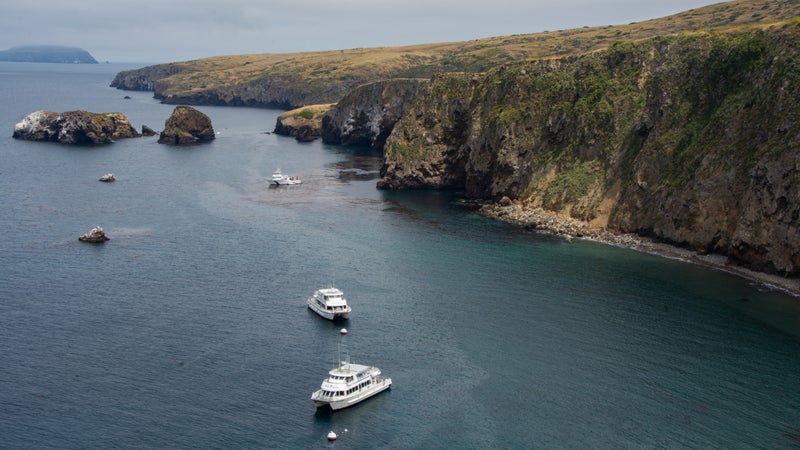
It’s about a 90-minute drive from��Los Angeles International��northwest to Ventura Harbor, where boats depart for the islands. Alternatively, ��offers service between LAX and��the Four Points by Sheraton hotel, located at the harbor front.
While runs private (and pricey) flights to��Santa Rosa��and San Miguel, most people travel via ferry. Island Packers, the official park concessionaire, runs frequent trips to Santa Cruz and Anacapa year-round (one hour each way)��and to the other three islands spring through fall (roughly three to four��hours each way, depending on conditions). The crew does a fantastic job of whipping up excitement about the national park��and its surrounding waters, and they often have a guest naturalist or ranger on board to answer any questions. In addition, they will often stop for wildlife sightings and may even pilot the boat into Santa Cruz’s��Painted Cave, one of the longest sea caves in the world, if you’re in that��area. During a recent trip, we spotted a pair of humpback whales, along with a colossal pod of dolphins who were in cahoots with the pelicans, staging an elaborate routine to round��up fish for one another. Be sure to drop a few bucks in the tip jar (for the humans) on your return voyage.
Traveling between islands isn’t impossible, but it does require some logistical gymnastics. Island Packers offers occasional service between Santa Rosa and Santa Cruz, but otherwise��you’re rolling solo. Experienced boaters and kayakers who are equipped with proper safety and navigation gear can island-hop if the weather cooperates, but research landing and camping options ahead of time. There aren’t many,��and with the exception of Scorpion Cove and its nearby campground, few are convenient. It’s also possible to pilot your own craft from the mainland to the islands, although you’ll be traveling across major shipping lanes—not an endeavor for the faint of heart.
When��Is the Best Time of Year to Visit Channel Islands?
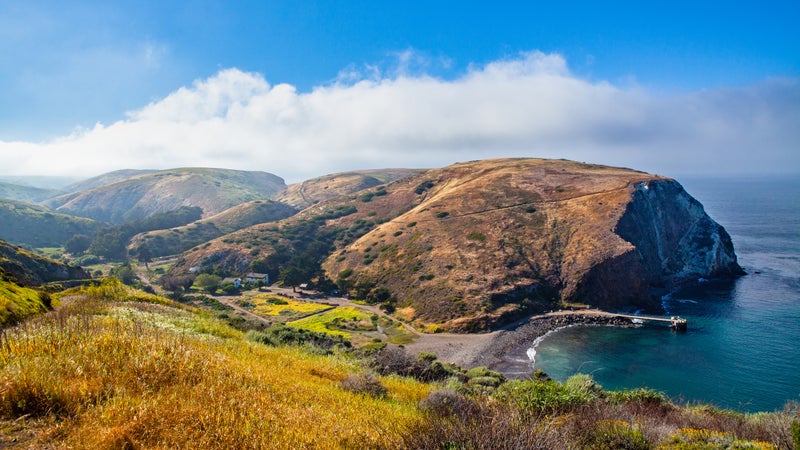
Winter
Come December, it’s not just colder, hovering in the low sixties��during the day and the high thirties��at night, but also stormier, with the likelihood of rain and high winds increasing through March. The upside to a late-winter visit is that the islands practically glow with chlorophyll, and wildflowers add even more color—my favorite is the giant coreopsis, whose daisylike yellow blooms and feathery foliage cluster at the end of twisted, woody branches, giving it��a somewhat Seussian appearance. Mid-December also marks the beginning of the annual gray whale migration; scan the channel as you cross to see if you can spot their misty spouts.
Spring
As daytime temperatures rise to the high sixties��and��rain decreases in frequency, the greenery fades. But luckily, flowers continue to dot the landscape, and whales keep on swimming in the vicinity. Come April, seabirds—including western gulls and California brown pelicans—begin nesting in earnest. This is especially obvious on the tiny island of Anacapa, where they usually kick back en masse until mid-August. Plan your visit to this mini��chain of three islets for any other time of year, unless you enjoy dodging poop missiles while accompanied by the dulcet tones of incessant squawking.
Summer
This is the most popular time to visit the islands, when air and water temperatures climb to their warmest, in the seventies,��and children��are out of school.��Weather conditions—and thus��ocean conditions—are also typically at their calmest, creating excellent underwater visibility for swimmers, snorkelers, and divers. The odds also increase for marine-wildlife sightings, since blue and humpback whales are migrating past the Channel Islands during��these��months.
Fall
Water temperatures reach their peak in early fall, which makes this the best season to take a dip if you’re so inclined. Autumn is also prime time to witness seabirds and elephant seals settling into their nests and rookeries around the park; just remember to give these island residents their privacy. By October, the infamous Santa Ana winds begin to pick up, blowing hard through January.
Where to Stay near Channel Islands
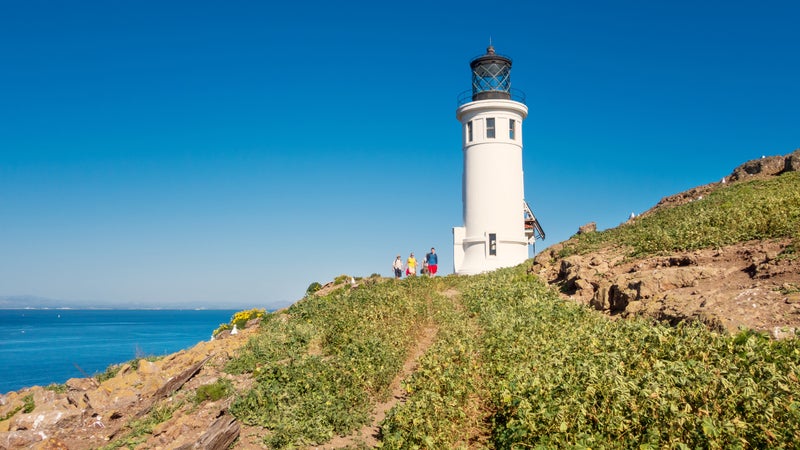
Campgrounds
A single walk-in campground is available on each of the islands, with the exception of Santa Cruz, which has two. To reach them, plan to hike anywhere from a quarter-mile to a full mile (and up a steep flight of stairs on Anacapa) with your gear. Reservations are required and can be made up to six months in advance via ($15). It’s also possible to reserve space on several of Santa Rosa’s remote beaches from mid-August to December ($10). No matter where you intend��to snooze, book your ferry ticket first, since those get snapped up quickly.
Hotels
While there isn’t any brick-and-mortar lodging on the islands, you’ll find a pair of chain hotels at the Ventura harbor, located only a mile from the ferry, with more scattered along the coast. I can vouch for the ��(from $170), which features serene landscaped grounds and what I can only describe as a hot-tub terrarium (trust me, that’s a good thing). Closer to downtown and its popular pier, the almost��beachside ��(campsites from $59; trailers from $175) features over a dozen quirky vintage trailers for rent, along with even more space to park your own (BYOT, if you will). For a more refined aesthetic, splash out for a stay at one of the two century-old Craftsman-style��cottages at the����(from $127), a property built in 1910 that has long hosted Hollywood luminaries and others who appreciate historic architecture (and ocean views).
What to Do While You’re There
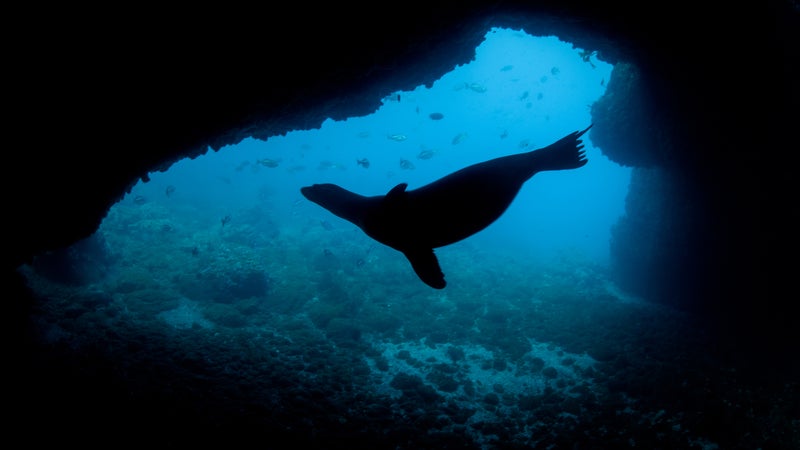
Hiking
Santa Cruz (Limuw��in the Chumash language) is the park’s most popular destination and its largest at 62,000 acres. Only 24 percent��of the island is accessible to visitors, however, since the Nature Conservancy manages the remaining acreage. There’s still too much to see in a day (or even two), so spend a night if you can. My favorite day hike is the 7.5-mile round��trip from Scorpion Anchorage to Smuggler’s Cove, climbing to the fox-filled grasslands atop the island before dropping down to a pebble-strewn beach littered with tide pools. On the north side of the island, it’s only a five-mile��round��trip to score an eagle’s-eye view of the rugged coastline and brilliant blue waters at Potato Harbor; if you’re short on time, the two-mile Cavern Point Loop keeps you closer to Scorpion Anchorage while still offering a bluff-top vantage. For something less traveled, stroll the 4.5-mile Scorpion Canyon Loop, which serves as prime habitat for the bright blue island scrub jay, a species endemic to Santa Cruz.
The second-largest island, Santa Rosa (Wima), is also flush with trails. It might be tempting to park yourself on the pristine white sands that curl around Bechers Bay near the landing dock, but make time to��soak in the landscape. Day-trippers will be able to complete the 3.5-mile Cherry Canyon Loop, which follows a thin singletrack through its namesake gorge before depositing you atop a bluff with exceptional views of the coastline and rugged interior. If you’re staying longer, extend the route for a total of eight miles to tag 1,298-foot��Black Mountain and enjoy the 360-degree panoramas at��its summit. From the dock, it’s about 4.5 miles one-way to the mouth of Lobo Canyon, a winding slot of wind- and water-carved sandstone that travels roughly 1.5 miles before spilling out onto what feels like your own private beach.
San Miguel (Tuqan) is the park’s westernmost island, which means it’s susceptible to the gnarliest weather; windbreakers are all but mandatory. Due to possible unexploded ordinance (the Navy once committed the sacrilege of holding bombing practice here), unaccompanied visitors are restricted to a relatively small chunk of island’s northeastern quadrant near the ranger station. That’s why it’s worth it to call ahead and��ensure that a ranger is available to guide the 16-mile out-and-back traverse to Point Bennett, where you can gawk at a gaggle of chatty seals and sea lions living their best lives at one of the most densely populated rookeries in the world.
Hiking opportunities are slim on tiny Anacapa (Anyapax) and Santa Barbara (Siwot). On the former, a 1.5-mile round��trip drops you at Instagram-worthy Inspiration Point, while a 2.5-mile out-and-back to Elephant Seal Cove on the latter treats you to a sweeping view of its namesake pinnipeds in beachy repose.
Backpacking
Limited campsites and potable water make backpacking a little tricky. On Santa Rosa, reserve a backcountry beach-camping permit, then strike out from the dock to hike 12.4 miles along the unpaved former ranch road that traces Water Canyon before reaching prime spots near the mouth of La Jolla Vieja Canyon. Dispersed camping is available along the beach; be sure to pitch your tent above the high-water mark. On Santa Cruz, book a spot at the remote, oak-dappled Del Norte backcountry camp. This lofty perch, with only four designated sites, is a short 3.5 miles from Prisoner’s Harbor, but it feels more deliciously remote if you use it as a waypoint during a 24-mile loop from Scorpion Anchorage.
Kayaking
Listen, I’m a hiker through��and��through, but the best experience I’ve ever had at the park was sea-kayaking near Scorpion Anchorage. Unless you’re an experienced paddler, book a tour through ��(from $118), which provides knowledgeable guides like Graham, along with all the equipment you’ll need for a few hours or a half��day on the water. If you are already one with the ocean, rent a kayak from ��(from $12.50 per hour) at least one day before your trip, or bring your own (contact Island Packers to make sure they have room on board; kayak transport is��$20 to $28 on top of your ferry-ticket price, depending on its size). Scorpion Anchorage features the friendliest waters, followed by Anacapa, where you’ll find incredible tide pools at isolated Frenchy’s Cove. Due to their more unpredictable weather and waters, touring the outer islands is only recommended for the most experienced paddlers.
Snorkeling and Diving
Roughly half of Channel Islands National Park is underwater, with its boundary stretching a nautical mile out from shore;��a zone six nautical miles beyond that is protected as a national marine sanctuary. This makes the park’s waters an extraordinary place to view marine life. Channel Islands ���ϳԹ��� Company also leads beginner-friendly snorkel tours at Scorpion Anchorage, where you’ll marvel at sunlit kelp forests brimming with sea life, including the neon orange garibaldi, California’s state marine fish. Experienced snorkelers and divers will also enjoy the biodiversity in the waters surrounding Anacapa and Santa Barbara Islands. Wetsuits are recommended year-round. Snorkeling gear rentals are available via��Channel Islands ���ϳԹ��� Company (reserve equipment��before arriving on the island); divers can rent their gear��back on the mainland at , located in the harbor.
The Best Places to Eat and Drink Around Ventura
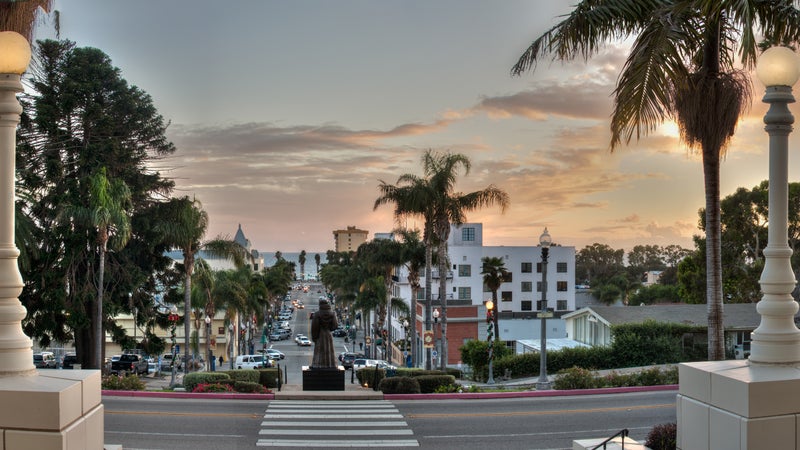
Nearly every time I��take��an early ferry to the islands, I make a quick pit stop at the , just��a short walk��from the Island Packers office. It��serves a thick-as-your-arm Hawaiian-inspired burrito stuffed with pineapple and Spam. And ask about its lunch boxes to go. After your return, linger awhile at the harbor to replenish your carb stash at (start with the yuca mojo de ajo), nosh on seafood classics at , or cool off with the frosty Technicolor concoctions dished up at .
Slightly farther afield, even carnivores will find plenty��to sink their teeth into at the punk-inspired , which serves up hearty, meatless riffs on all-American classics. Opt for the��Mr. BBQ jackfruit sammy with a side of Nardcorn, a loose-kernel version��on elote. The same unassuming strip mall features the , a brunch joint whose bold claim to “The Best Homemade Chorizo in Ventura” I cannot deny. There’s even more to choose from in the heart of downtown. A local pal of mine is a fan of the curries at , another friend makes a habit of��stopping for a few island potions at , and I personally can’t wait to sample more of the fare��at tucked-away , the seafood-heavy California outpost of a Belizean gastropub. For a more casual experience, grab some local craft brews (more on this in a moment) and head to nearby San Buenaventura State Beach, where you can tuck into briny bivalves at the��.
If You Have Time for a Detour
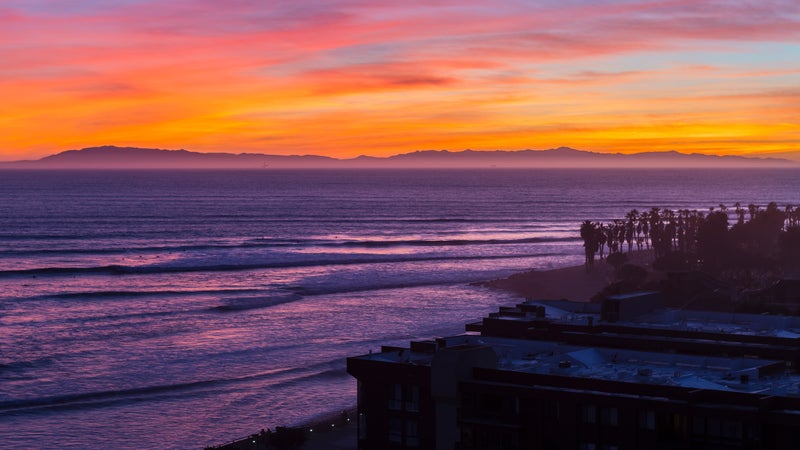
Immortalized in song (press play on the Beach Boys’ “Surfin’ U.S.A.” if you don’t believe me), Ventura is one of the world’s most iconic surfing locations. Grab your board and head to—wait for it—Surfer’s Point, a popular break near the downtown pier; tamer waters roll in��a few minutes up the coast at Mondo’s Beach. Less than 15 miles north of downtown Ventura, , home to the annual Rincon Classic, draws experienced surfers to a trio of good breaks. If you don’t have a board, rent one from the old-timers at , which has been catering to��wave hounds since the sixties. If you don’t have the skills, learn from the crew at ;��they teach groms of all ages.
For a short stroll or run, check out pastoral , which slices through the mountainous foothills perched at the city’s northern edge. For something a little more adventurous, the rugged fans out to the north, with the rising from the Pacific just a half-hour to the southeast. Cyclists will find plenty to enjoy in both of these areas, but there’s also great cruising right in town along several paved routes, including the 12-mile Ventura Pacific Coast Bikeway and the 16.5-mile Ventura River Parkway. Rent your wheels (or schedule a tour) at .
Finally, book an extra night in your hotel (and secure��a designated driver) so that you can partake in samples offered by��the region’s many purveyors of adult liquid delights. While the central coast’s famed wine country isn’t all that far away, Ventura is better known for its craft-brew scene, which includes (which keeps several gluten-reduced beers in rotation), (whose Donlon Double IPA snagged a World Beer Cup award in 2018), and brand-new (whose Peelin’ Out incorporates locally grown tangerines). That said, I truly can’t wait until I can once again kick back and sip a dreamy, creamy Tux Nitro Milk Stout in the perfectly chill beer garden at ’s Colt Street headquarters, located just east of the harbor. Save room to visit the tasting room at , a distillery that uses overstock and less��than��perfect produce from area farms (and in the case of its agave spirit, plants that people no longer want in their yards) to conjure up a host of aromatic elixirs. Try its��Wilder Gin, which tastes like all of my favorite California plants decided to get boozy together.
How to Be Conscious
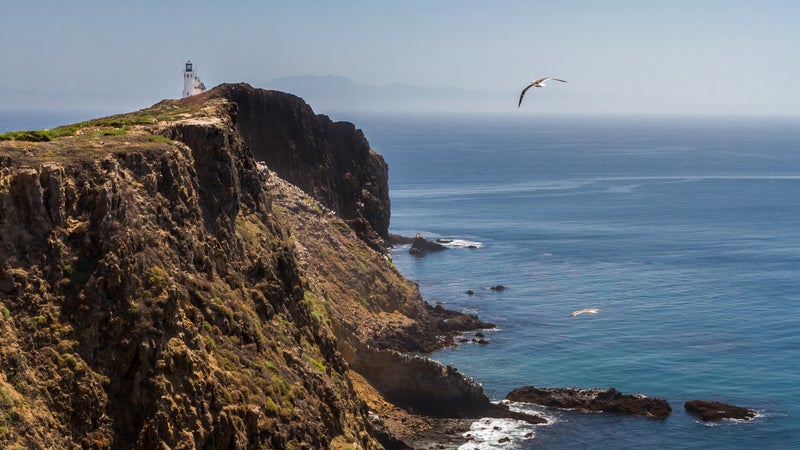
There are no trash receptacles anywhere on the islands, so pack out everything you brought along for the adventure, including fruit peels and pits. I carry a reusable zip-top bag along for this purpose, just as I do when traveling anywhere in the backcountry.
Wildlife is one of the major draws of a visit to the Channel Islands, and it’s important to give our furry, finned, and feathery friends ample space to live their lives in peace while we gawk in wonder. This is especially important when seabirds and pinnipeds are caring for their young, which is why beach camping is not allowed on Santa Rosa from January through mid-August. The park suggests giving a 100-yard berth to any nesting or pupping wildlife, since our presence can spook away the parent, leaving their eggs or young unattended and vulnerable. For this same reason, tamper your squeals of joy and avoid shining lights if you enter sea caves while kayaking, since animals enjoy cozying up inside.
You can also protect the park’s wildlife by storing food in critter-proof containers, such as hard-sided coolers or the lockers provided at campsites and picnic tables. The ravens, mice, and foxes here are bold and skilled, especially on heavily touristed Santa Cruz, where they’ve evolved to learn how to open (and close—so stealthy!) zippers. Graham��shared that a cunning avian thief once swiped his car keys, which he later discovered dangling from a dock halfway around the island.
